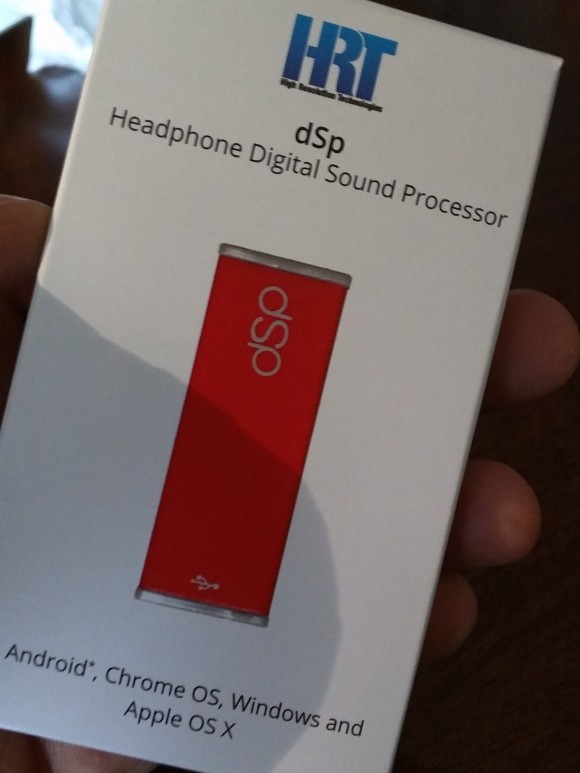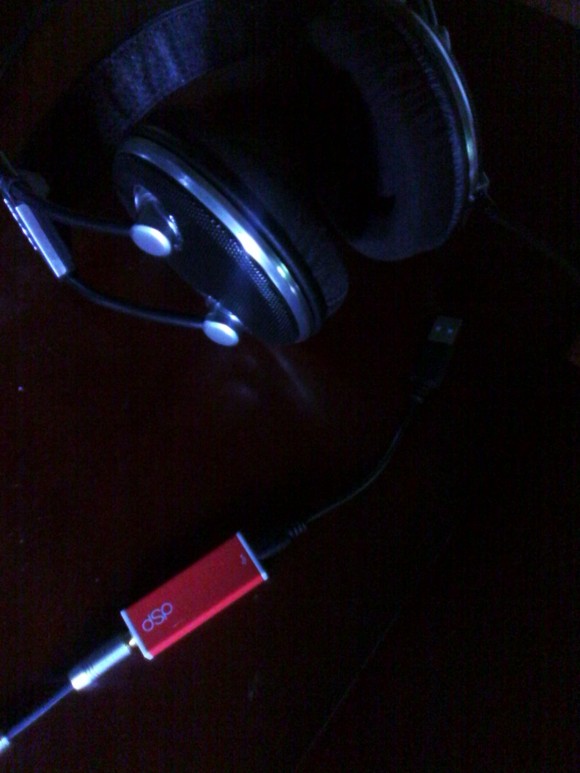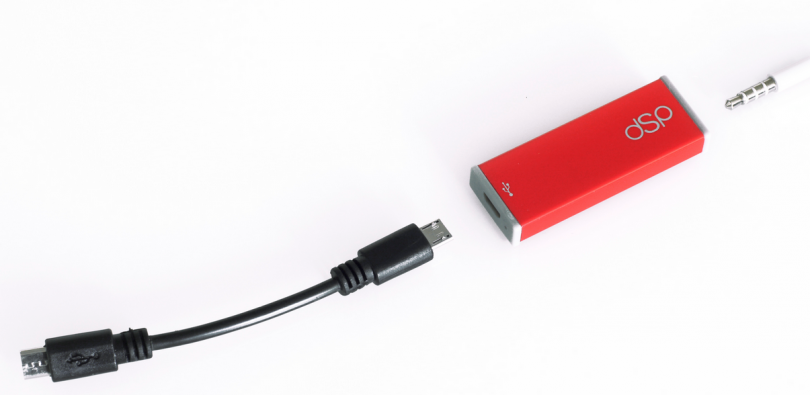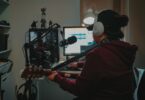aNewDomain — Here at aNewDomain we love to dive deep into product reviews. We’ve got a double feature today — a two-part, hand-tested review of the HRT dSp dongle. Music editors Ant Pruitt and Brant David weigh in on the device.
Ant Pruitt on HRT dSp
The High Resolution Technologies dSp dongle claims to allow those of us that aren’t audiophiles (or invested in audiophile-quality gear) to enjoy music with high quality sound. The dSp reminds me of a digital to analog converter (DAC), though I can’t prove that the device from HRT is an actual DAC.
The dSp in form and function is a small device with two ports: a headphone jack and a USB power port. It’s billed as an easy, plug-and-play enhancer for all audio tracks. First, you must know that using the dSp requires you to have a nice set of headphones. The typical earbuds that come with your iPhone will not allow you to hear the difference in quality and clarity. I’m using my favorite Sennheiser HD 380 Pros for my testing.
What am I listening to?
 For testing purposes, I selected multiple qualities and types of music — from low bitrates of 128KB per second and high bitrates of 1028KBps to compressed mp3 files and high-fidelity lossless FLAC files.
For testing purposes, I selected multiple qualities and types of music — from low bitrates of 128KB per second and high bitrates of 1028KBps to compressed mp3 files and high-fidelity lossless FLAC files.
I also selected different genres, which ranged from the smooth rhythmic beats of Paul Hardcastle, to old blues from Albert King, to big bass pounding tracks from Outkast. As expected, I gathered varying results from all the different types of music as well as file formats.
Bitrate
Bitrate ended up playing a small part in this testing. The idea that the higher the bitrate, the higher the sound quality, is just not true. It also depends on the composition and the final mix of said composition. Some artists aim for a lower-end sound, like big bass tracks from ’90s hip-hop. Others aim for a more balanced mixdown that allows all voices to come through evenly, such as the music from the great John Williams and the London Symphony Orchestra.
The dSp took all of that into consideration and presented varied results.
The older, compressed hip-hop tracks were already bass heavy. The dSp amplified that. The audio gains were literally pushed almost 3 times as loud on my ears. It wasn’t a great sound or a bad sound. Just louder and filled with more bass.
The compressed tracks with a balanced mixdown didn’t show much of an enhancement at all. Again, the tracks were louder, but there wasn’t an enhancement to the quality of sound. After many listens it really seems as if the older audio that was mixed in an era of less sophisticated studio equipment gains better sound quality from the dSp, while those mixed in the modern era simply increased in volume.
The high fidelity tracks I tested already sounded great, but the dSp made these audio files absolutely sing! I’ve listened to audio knowing the drummer is hitting a hi-hat to enhance the beat, but my ears usually process that noise as something like an Independence day fireworks fuse — “Sssssss” is all you hear. But in this case, with the dSp, there was no mistaking the different levels and tones of an audio file. You clearly hear the low, mid and high range areas of the tracks. That hi-hat sounds like a hi-hat should.
Conclusion
Priced at $69.99 the dSp is an interesting buy. It’s definitely worth the money if you have quality headphones, like my Sennheiser HD 380 Pros. Old lossy files and high fidelity music sounds great on this small gadget, and it’s a whole lot cheaper than audiophile gear.
Brant David on dSp:
My colleague, Ant Pruitt, has already introduced the HRT dSp headphone digital sound processor unit to you. I, too, received a unit and we proceeded to independently assess the dSp. Our dual, simultaneous testing and reviewing was done with the full knowledge and support of an HRT PR agent.
What am I listening on?
 The dSp ran through my headphones of choice, the Pioneer SE-A1000 open stereo headphones. (Note that the small, rectangular, wafer-like dSp is not a stand-alone device; you must run headphones through it the way an electric guitar player runs his guitar through his effects pedal(s) before his cord or wireless signal reaches his amplifier.) These top-quality, over-ear headphones originally retailed for $120 but easily pass for $200-$250 headphones. (As a brief aside, I see that they now sell, new, for $59 on the Internet. That’s a steal, for those interested. I’ve loved Pioneer audio tech since I was a little boy in the dim and distant 1970s.)
The dSp ran through my headphones of choice, the Pioneer SE-A1000 open stereo headphones. (Note that the small, rectangular, wafer-like dSp is not a stand-alone device; you must run headphones through it the way an electric guitar player runs his guitar through his effects pedal(s) before his cord or wireless signal reaches his amplifier.) These top-quality, over-ear headphones originally retailed for $120 but easily pass for $200-$250 headphones. (As a brief aside, I see that they now sell, new, for $59 on the Internet. That’s a steal, for those interested. I’ve loved Pioneer audio tech since I was a little boy in the dim and distant 1970s.)
And back to the review …
As Mr. Pruitt mentioned, the dSp will be next to worthless if you don’t already own decent-quality headphones. Earbuds or cheap Skull Candy headphones aren’t going to work for this endeavor.
I listened to music and media from a variety of sources: streaming via Google Play and Rdio, iTunes purchased downloads, RCA E-Music purchased downloads, BBC Music Magazine MP3 downloads (for classical music only), Compact Discs and samples of music from HD Tracks.
Most of the music I listened to was played on my HP-Compaq laptop with Windows 7. (Yes, people, I’ve been holding out for Windows 10). Some of it was played on my tablet (Google Play tracks only). Both my laptop and tablet run graphic EQ apps, which I highly recommend.
The Music
I listened to a wide array of musical genres and sub-genres. These included: heavy metal like Iron Maiden, hard rock like Led Zeppelin in concert, progressive rock like Rush, ELP and Knight Area, blues and blues rock like Cream, Stevie Ray Vaughan and Ana Popovich, “old school style” R&B like Allen Stone, Joss Stone and Sly Stone (wait, is there a pattern here?), jazz like Miles Davis, Dave Brubeck and “The Duke,” classical, which ranged from classical guitar to a fully symphonic Beethoven’s 9th and some so-called “new age” stuff like Michael Hedges and Liz Story.
My Conclusions
My conclusion about the device is simple. The older and more analog-like the track I listened to, the more the dSp enhanced the sound of it.
Newer (original recordings done within the last 20 years) and denser (higher bitrate) tracks sounded virtually the same with or without the dSp hooked up. As I journeyed further back in time (musically speaking), the tracks got more of a boost and increased in clarity. Likewise, the less modern day re-mastering or re-mixing, the greater the positive effect of the dSp.
The sonic enhancements, when they were present, were basic, elemental ones. There was increased volume and punch without any distortion. I could hear increased clarity and separation of instruments. Although we didn’t listen to any vinyl records, my educated guess is that the dSp would significantly upgrade the enjoyment level of listening to vinyl via headphones, assuming the headphones were of sufficiently good quality.
So, there you have it. If you don’t want to invest in a lot of expensive, audiophile equipment but still desire to hear music better through your quality headphones, the HRT dSp is a good choice.
For aNewDomain, this has been Ant Pruitt and Brant David.
Images in order: Screenshot courtesy of HRT; dSp box by Ant Pruitt; dSp and headphones by Brant David













